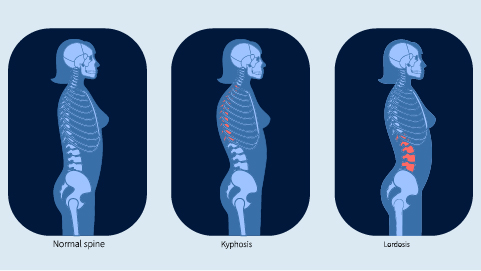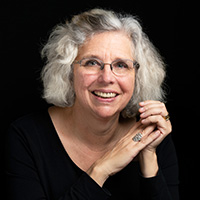
A client has Scheuermann’s disease: a genetic malformation of vertebral bodies that arises during adolescence. But the client also has some other issues: anxiety, joint and back pain, clicking, popping, and crepitus. How much of this is due to Scheuermann’s disease, and how might manual therapy be able to help?
Plus, in this episode of “I Have a Client Who . . .” Pathology Conversations with Ruth Werner, we get to talk about Schmorl’s nodes!
Resources: 
Pocket Pathology: /abmp-pocket-pathology-app
Administrator (no date) Kyphosis. Available at: https://rothmanortho.com/specialties/conditions/kyphosis (Accessed: 8 November 2022).
Bezalel, T. et al. (2014) ‘Scheuermann’s disease: Current diagnosis and treatment approach’, Journal of Back and Musculoskeletal Rehabilitation, 27(4), pp. 383–390. Available at: https://doi.org/10.3233/BMR-140483.
knadmin (2017) ‘Scheuermann’s disease’, PM&R KnowledgeNow, 10 March. Available at: https://now.aapmr.org/scheuermanns-disease/ (Accessed: 8 November 2022).
Mansfield, J.T. and Bennett, M. (2022) Scheuermann Disease, StatPearls [Internet]. StatPearls Publishing. Available at: https://www.ncbi.nlm.nih.gov/books/NBK499966/ (Accessed: 8 November 2022).
Scheuermann’s Disease | Kingsley Physio | More than your local Physio (no date). Available at: https://kingsleyphysio.com/common-conditions/scheuermanns-disease/ (Accessed: 8 November 2022).


Books of Discovery:www.booksofdiscovery.com
Advanced-Trainings: www.advanced-trainings.com
About Til Luchau and Advanced-Trainings.com:
As a Certified Advanced Rolfer™, Til was on the faculty of the Dr. Ida Rolf Institute® for 20 years, where he served as Coordinator and Faculty Chair of the Foundations of Rolfing Structural Integration program. The author of the Advanced Myofascial Techniques textbook series (which has been translated into 6 languages), his regular Myofascial Techniques and Somatic Edge columns have been featured in Massage & Bodywork magazine since 2009, and (along with Whitney Lowe) he co-hosts the popular Thinking Practitioner Podcast. He is the Director of Advanced-Trainings.com which since 1985 has offered short, credit-approved professional trainings and certification for manual therapists of all types, in person and online.
Website: Advanced-Trainings.com
Email: info@advanced-trainings.com
0:00:01.2 Ruth Werner: Hey, I Have a Client Who listeners. Did you know I have a growing library of NCB-approved one-hour online self-paced continuing education courses that you can do anytime, anywhere? Well, now you know. Current classes include What's Next? COVID-19 Updates for Massage Therapists and A Massage Therapist's Introduction to Pharmacology part one, and brand new, A Massage Therapist's Introduction to Pharmacology part two. Classes are $20 each, and they confer one hour of continuing education credit. Wanna know more? Visit my website at ruthwerner.com and check it out. Be sure to sign up for my mailing list so you'll never miss a new class.
[music]
0:00:56.0 RW: Hi, and welcome to I Have a Client Who, Pathology Conversations with Ruth Werner, the podcast where I will discuss your real life stories about clients with conditions that are perplexing or confusing. I'm Ruth Werner, author of A Massage Therapist's Guide to Pathology, and I have spent decades studying, writing about and teaching about where massage therapy intersects with diseases and conditions that might limit our client's health. We almost always have something good to offer even with our most challenged clients, but we need to figure out a way to do that safely, effectively and within our scope of practice, and sometimes as we have all learned, that is harder than it looks. Today's episode is about a fascinating condition that is related to but not quite the same thing that many massage therapists face every day.
0:01:51.0 RW: I'm talking about hyperkyphosis, something we see often with older people, mostly females associated with osteoporosis, but in the situation I'm going to talk about, it occurs in an entirely different segment of the population. This is Scheuermann's disease, and unlike the stooped shoulders and crunched neck that we see in mostly ladies of a certain age, this one has nothing to do with age-related bone thinning, and our story goes like this. I need an episode on Scheuermann's kyphosis and the fun popping clicking in every joint of the body that can come with it. Huh, well, that sounds to me like hyper-mobility, which is not something I associate with Scheuermann's disease, but let's dig a little deeper. Shall we? When I asked for more input, our contributor said this. My client has extreme anxiety and is a recovering addict, but all of their joints audibly pop and click often. They seem to have some breathing behaviors. I'm not sure if that's anxiety-related.
0:02:57.3 RW: They were prescribed a ton of meds for pain associated with Scheuermann's, lots of crepitus. They would report to me about restrictions in their tissues. I think a lot of their experiences are based on their anxiety. Okay, let's talk about Scheuermann's disease. First of all, we have multiple names, and that sometimes indicates a condition with a lot of confusion behind it. Some of the other names for Scheuermann's disease is the Scheuermann's kyphosis, Calvé disease, juvenile osteochondrosis of the spine, juvenile kyphosis, or juvenile discogenic disease. And from this, we can derive that this has something to do with spinal issues in younger patients. It's named after a Danish surgeon, Holger Werfel Scheuermann, who was an important and influential doctor until his retirement just in 1947. Interestingly, early in his career in the 1910s, Dr. Scheuermann was an assistant in the departments of roentgenology, what we would today called radiology and massage at... And forgive my pronunciation, Rigshospitalet, which is today the largest hospital in Denmark.
0:04:16.1 RW: He went on to specialize in radiology and orthopedic surgery. Here is how a continuing education article at the National Library of Medicine describes the condition named for Dr. Scheuermann. Scheuermann's disease is a condition of hyperkyphosis that involves the vertebral bodies and discs of the spine, identified by anterior wedging of greater than or equal to 5 degrees in three or more adjacent vertebral bodies. The thoracic spine is most commonly involved, although involvement can include the thoracolumbar and lumbar region as well. Okay, so picture this for a moment, wedge shaped vertebral bodies in the thoracic spine, and those wedges are making the spine lean forward. Up that in your head. Now, picture Quasimodo. It is very likely that Victor Hugo was describing a person with severe scoliosis and kyphosis in The Hunchback of Notre-Dame. If this was present from birth, this would be called congenital kyphosis, but if it develops during childhood, then it might be juvenile kyphosis, which is also known as Scheuermann's disease.
0:05:34.1 RW: This condition is typically found some time between the ages of 12 and 17, when a teenager develops a pronounced hunchback sort of appearance. How common Scheuermann's disease appears to be is questionable. I found a variety of resources that put it at affecting somewhere between 0.4 to 10% of the United States population. A, that's a huge range, and B, even the lower number of 0.4% seems shockingly high to me, but the studies that found these numbers are relatively recent within the last 10 years anyway, and they are based on large scale population surveys, and as you listen on this high number might become less alarming, I am very happy to say. There's also some controversy about who is most affected. It's typically diagnosed in adolescents, that's clear, but some sources say it is more common among females, most say it is most common among males, and at least one resource says the distribution between sexes is about even. This drives me crazy.
0:06:46.6 RW: The most common form of Scheuermann's disease affect the mid to lower thoracic spine with the apex of the curve at somewhere between T7 to T9. This along with age, of course, helps to distinguish Scheuermann's disease from the much higher distortion that we often see with osteoporosis, because that tends to happen at the top end of the thorax. There's another version of Scheuermann's disease that affects the thorax and lumbar spine, and there the apex of the curve is at about T10 to T12. So what causes this to happen in teenagers? It appears to be hereditary, but the exact genetic mutation hasn't been found. The prevailing assumption has been that it's a problem in the growth pattern of vertebral bodies, but there's a new-ish theory that suggests the dysfunction seen with Scheuermann's disease is not about bone formation, instead, it's about how the intervertebral cartilages connect to the vertebral bodies, and here's what I found in that National Library of Medicine article.
0:07:54.6 RW: One growing theory, they say, supported by histologic findings suggests discordant vertebral endplate mineralization and ossification during growth, which causes disproportional vertebral body growth and resultant classic wedge-shaped vertebral bodies that lead to kyphosis. That vertebral endplate, they're talking about, that is the connecting surface between the bone and the cartilage, and according to this article, when that endplate doesn't mineralize and ossify correctly, the whole shape of the bone changes to look like a wedge, stack up three or more of these in a row and that is a permanent postural distortion, which can range from mild to extremely severe. And one unique finding in Scheuermann's disease is that sometimes the disc materials might ooze out from weakened areas in the vertebral endplate. These little areas have an irresistible name, they are called Schmorl's nodes.
0:09:01.7 RW: I'm intrigued by this focus on how the inter-vertebral cartilage interacts with the endplate and the vertebral bodies, because those vertebral endplate junction failures turn out also to be a big factor in disc disease, and that's an umbrella term for disc bulges and herniation and a slew of other problems. And to my knowledge, this point of focus about vertebral endplate junction failure has not made it into a lot of public discussion about disc issues, and I find that a bit surprising because it opens up some new possibilities for treatment or even prevention of disc problems, but that's a topic for another day. When scientists look for contributing factors to Scheuermann's disease, we see this, abnormal collagen to proteoglycan ratios. That is frighteningly close to chemistry, so I will interpret. One possible issue with Scheuermann's disease is a disruption in the quality and construction of connective tissue, which makes me think about our contributor's observation about what they called the fun popping/clicking in every joint of the body that can come with Scheuermann's disease.
0:10:20.1 RW: So this seems like a good segue to talk about Scheuermann's disease signs and symptoms. The main ones, of course, are the development of a postural distortion along with thoracic pain. The physical deformation is rigid, it doesn't change or adjust with a change in position like standing up straight or lying supine, and accompanying postural compensation can also involve lordosis and scoliosis and really tight hamstrings, and all together, this can cause substantial back pain. Most people say the pain is worse with activity and improves with rest. I looked for any information I could find that might link hypermobility or joint popping and clicking to Scheuermann's disease, and I came up empty. So I have nothing to offer our contributor on that particular observation, sorry. If the case is very severe, a couple of other problems can arise, compression of the thorax, which can impair breathing and increase the risk of pneumonia, plus that might also add to the possibility of anxiety since that's very much tied up in our experience of breathing.
0:11:29.9 RW: And Scheuermann's disease can also increase the possibility of nerve irritation related to the changing shape of the vertebrae. But I found some really good news, and that is that most people with Scheuermann's disease don't progress to the most severe extremes, and they can usually manage it with physical therapy and some painkillers. If the curve is severe during adolescence, the person might wear a brace for one or two years, this doesn't reverse any progression, but the theory is it could prevent the kyphosis from getting worse, although the jury is out on how effective that really is. And if it's absolutely needed, then spinal surgery can correct this problem, but of course, this is invasive and it has a lot of possible complications, so we avoid it, if possible. It turns out the majority of people with Scheuermann's disease don't need surgery.
0:12:22.4 RW: They are prone to back pain and generally report a lower health-related quality of life compared to others, which to me suggest that there's a possible role for massage therapy, not to fix or correct Scheuermann's disease, but to address pain and compensation patterns that could be improved. Several famous athletes have been diagnosed with Scheuermann's disease, that was a surprise to me. From my limited understanding of this condition, I couldn't imagine that someone's physical function would allow for peak athletic performance. Love to be wrong about things like that, and all of this adds to my evolving concept about Scheuermann's disease, that it isn't a sentence to a life of physical limitation and with the right physical therapy and manual therapy and occupational therapies and other simple interventions, someone with this condition could absolutely live a full and fulfilling life. So is there a role for massage therapy in the situation? Absolutely.
0:13:23.3 RW: I actually managed to find a few research articles that referenced the integration of manual therapies into Scheuermann's disease management, although none of them were available to me without a subscription, so I did not access the full articles to find out what was meant by manual therapy here. But in that context, it usually translates to work that is within our scope, and if we think about this in the context of the client our contributor was describing, we need to consider the effects of pain medications, of course, because these may influence how the person takes in our work and we need to be more conservative, but this client also seems to experience a lot of anxiety. Huh, I wonder if massage might help with that. Well, the evidence on massage therapy and anxiety is consistently clear. Welcomed, educated, structured touch is terrific for anxiety. I think if we are invited to be part of the way a person manages their Scheuermann's disease, then we can step up to that challenge with enthusiasm and confidence. What a great opportunity to coordinate our work with the physical therapist or occupational therapist or other specialist who is helping this patient live their life to the fullest.
0:14:38.7 RW: Hey everybody, thanks for listening to I Have a Client Who, Pathology Conversations with Ruth Werner. Remember, you can send me your I Have a Client Who stories to ihaveaclientwho@abmp.com. That's, I have a client who, all one word, all lowercase at abmp.com. I can't wait to see what you send me and I'll see you next time.
[music]